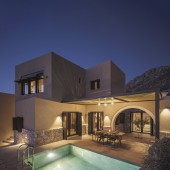Askianos Single Family House by Natalia Kokosalaki |
Home > Winners > #142619 |
 |
|
||||
| DESIGN DETAILS | |||||
| DESIGN NAME: Askianos PRIMARY FUNCTION: Single Family House INSPIRATION: Traditional Cretan architecture and a respect for the natural environment inspired us to design a home fully integrated into the Cretan hills. Local materials such as stone and ocher are used extensively throughout the design, and local craftsmen and artists have left their mark in the home. From the built in furniture to the fabrics and textiles, to the masonry stone and hand made ceramic tiles, Askianos is what pure Cretan living is all about. UNIQUE PROPERTIES / PROJECT DESCRIPTION: Askianos was designed for a family to use as a summer house in southern Crete. The home is split into two volumes by a staircase leading the view towards the summer sunset over the sea, whilst the masses are embedded into the landscape. Traditional elements and materials of Cretan architecture come together with clean minimal design, blending the building with the landscape, inviting both indoor and outdoor living. OPERATION / FLOW / INTERACTION: Circulation has been guided to frame prime views from the plot, and the home has been fully integrated in its natural environment on the hillside. The outdoor shower has been carved into the rocks, and the pool is built into the rock, too, inviting a tactile connection to the natural environment. PROJECT DURATION AND LOCATION: The home was completed in 2021 in Listaros, Crete. FITS BEST INTO CATEGORY: Architecture, Building and Structure Design |
PRODUCTION / REALIZATION TECHNOLOGY: Environmental and site analysis dictated the orientation of the house in relationship to the prime views and the position of the sun. Local stone and ocher were used in the construction, and all built in furniture was built by local craftsmen. In keeping with the traditional Cretan architecture the windows, doors, and shutters are all made of wood. SPECIFICATIONS / TECHNICAL PROPERTIES: 306 square meter home built on a 716 square meter plot of land. TAGS: Summer house, Crete, Greece, Traditional, Minimal, Slow living RESEARCH ABSTRACT: Type: Environmental analysis. Objectives: To orient and integrate the design into the site. Methodology: Solar and wind analysis using computational tools, view selection and framing from site visit. Data Tools Used: Energy Plus weather data for analysis and solar paths; historical wind data; site visits and research on local architecture. Participants: Full office team. Result: Environmental analysis optimized the design, historical research allowed for selection of construction materials and methods. Effect: The design respects the local architectural language, integrating it fully in its environment, and promoting local artists and craftsmen. CHALLENGE: Integrating the design into a small plot of land and respecting the natural topology, especially a large rock face on the side of the hill, which, by law, was considered a local landmark that had to remain untouched. From a social perspective, we had to ensure the design of the home would respect the local and historical design language. ADDED DATE: 2022-06-28 16:34:34 TEAM MEMBERS (2) : Architect: Natalia Kokosalaki and IMAGE CREDITS: Photographer: George Messaritakis |
||||
| Visit the following page to learn more: http://nataliakokosalaki.gr/portfolio/as |
|||||
| AWARD DETAILS | |
 |
Askianos Single Family House by Natalia Kokosalaki is Winner in Architecture, Building and Structure Design Category, 2022 - 2023.· Read the interview with designer Natalia Kokosalaki for design Askianos here.· Press Members: Login or Register to request an exclusive interview with Natalia Kokosalaki. · Click here to register inorder to view the profile and other works by Natalia Kokosalaki. |
| SOCIAL |
| + Add to Likes / Favorites | Send to My Email | Comment | Testimonials | View Press-Release | Press Kit |
Did you like Natalia Kokosalaki's Architecture Design?
You will most likely enjoy other award winning architecture design as well.
Click here to view more Award Winning Architecture Design.








